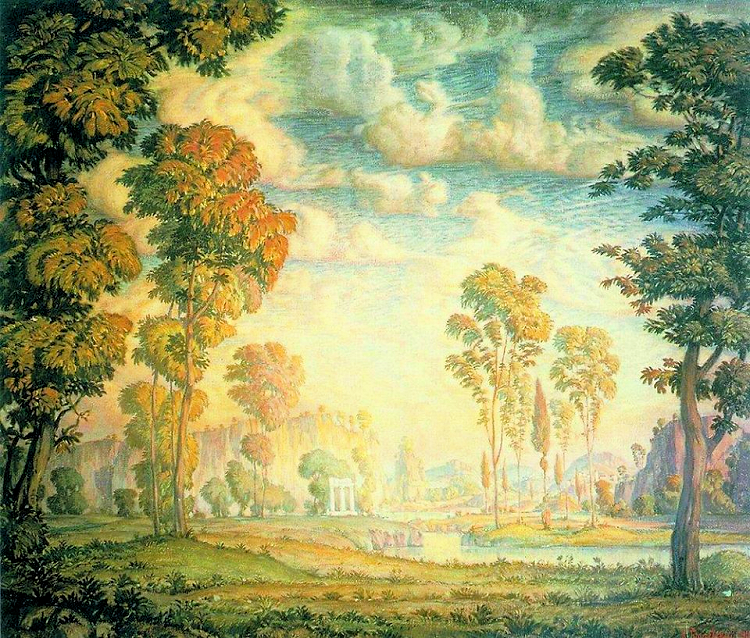 |
| Morning, 1910. |
 |
| Tropical Landscape, 1906. |
 |
| Southern Land - Cave Town, 1908. |
 |
| Altars, 1907. |
 |
| The Last Rays of the Sun, 1903. |
 |
| Romantic Landscape, 1908. |
 |
| Landscape with rocks - Stary Krym, 1908. |
 |
| Classical Landscape, 1910. |
 |
| A Cloud, 1910. |
 |
| Mount St. George, 1911. |
 |
| Italian Landscape, 1911. |
 |
| Earth Cimmerian, 1911. |
 |
| Landscape with a Castle, 1912. |
 |
| Ships, 1912. |
 |
| Eastern Altar, 1919. |
 |
| A Cloud, 1925. |
 |
| Landscape with Trees, 1927. |
 |
| Feodosia, 1930. |
 |
| Crimean Landscape, 1930. |
 |
| The Dnieper Power Plant, 1930. |
 |
| The City of the Future, 1932. |
 |
| Port of an Imaginary City, 1932. |
 |
| Evening by the Sea, 1940. |
 |
| Mountain Landscape, 1942. |
*
Konstantin Fyodorovich Bogaevsky (24 January/12 January OS 1872, Feodosia - 17 February 1943, Feodosia), Russian painter notable for his Symbolist landscapes. Born in the Crimea to an old Italian-German family he took first lessons in art from Ivan Aivazovsky and, from 1891 to 1897, he studied at the Imperial Academy of Arts under the tutelage of Arkhip Kuindzhi. There, his work was not appreciated and, at one point, he was even temporarily discharged from the Academy for "lack of talent". Despite this, Kuindzhi always had a high respect for his pupil and protected him. In 1898 he traveled to Italy and France where he became acquainted with the works of Claude Lorrain, a painter whose art was a great influence on his own. That same year saw his first exhibition, in Moscow. From 1900 he worked in his home town of Feodosia, his main theme being the landscapes of a non-existent land - known to his friends as Bogaevia - that he said he only saw in his dreams. His work began to gain in popularity after poet and critic Maximilian Voloshin published a series of essays on the artist, giving high praise to the symbolism in his paintings.
Bogaevsky was a member of
Mir iskusstva, Union of Russian Artists, and the
Zhar-Tsvet; his work was often compared to his contemporary Nicholas Roerich, a colleague in the first two organizations. In 1906 his paintings were included in the
Exposition de l'Art Russe organized by Sergei Diaghilev and held in the Petit Palais in Paris. He revisited Italy in 1911 and discovered the paintings of Andrea Mantegna, which were strongly influential on his own later work. He returned to Feodosia in 1912 where he remained for the rest of his life. After the Revolution he retreated into relative obscurity. He died in his home town at the age of seventy-one. In 1971 a minor planet was named in his honor: 3839 Bogaevskij.